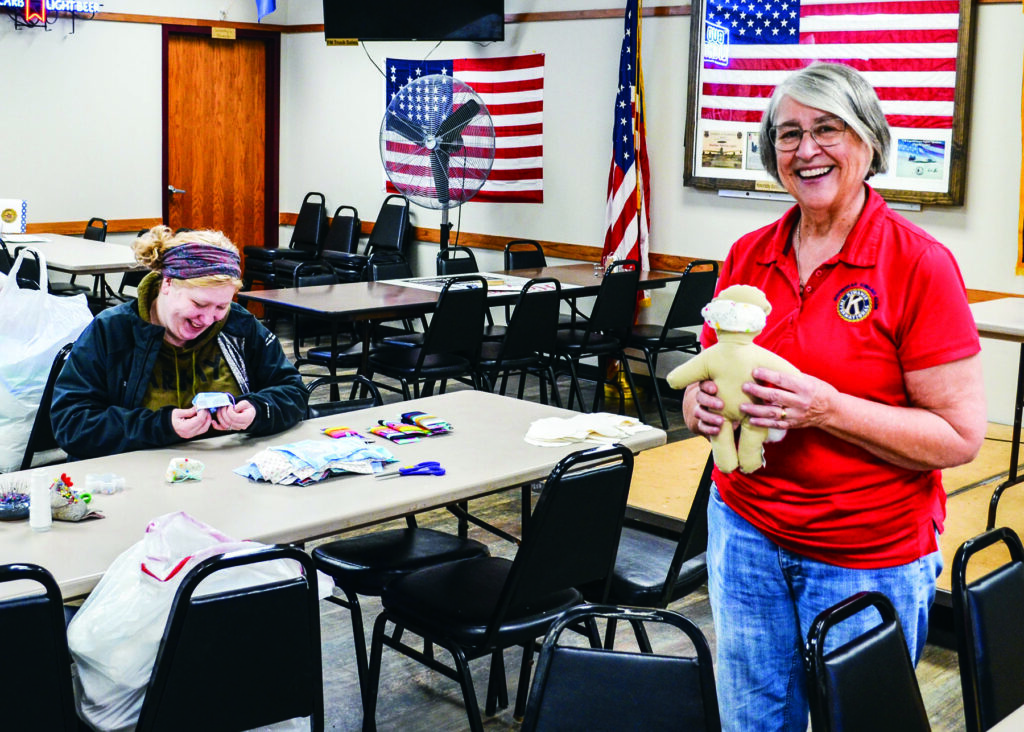
Kiwanians Gail Jordahl and Hannah Young work on trauma dolls to be donated to Sanford’s Children’s Hospital.
Moorhead’s original service club has been serving the community since April 2w, 1921 – a record that includes everything from planting trees along River Drive and helping establish Moorhead’s first golf course in its first year to providing Kiwanis Trauma Dolls to hospitalized children through the Children’s Miracle Network over the past decade.
“What means the most to me as a Kiwanian is working with kids,” longtime member Peter Larson reflects. Since joining 27 years ago, he has served as its president, as well as governor Minnesota Dakotas Kiwanis District 2 and the district’s youth protection manager. He is currently district finance and fund-raising chair. The retired IRS accountant was asked to become the club’s treasurer a month after he joined, he adds, and has served in that capacity ever since.
One of Moorhead Kiwanis’ proudest roles, he says, is sponsorship of the local Key Club, which it established 51 years ago at Moorhead High School. The thriving youth organization emphasizes service to the community and leadership skills. The club assists with the cost of Key Clubbers attending district training sessions; it also covers a stipend for its advisor.
The club holds a monthly birthday party for children at Micah’s Mission, the shelter operated by Churches United. Members also ring bells at Christmas for the Salvation Army, run a bean-bag toss at River Arts, and plant flower beds along the Eighth Street railroad crossings. They help at the Dorothy Day Food Pantry and the F-M Emergency Food Pantry, and pledged a major gift of $10,000 to the Miracle Field, the ball field for children of all abilities in Southside Regional Park. They have also pledged $10,000 to the inclusive playground now being planned nearby.
They chartered Moorhead’s second Kiwanis unit, Vikingland Kiwanis, in 1972. Over the years, they’ve assisted in chartering a Boy Scout troop and the area’s very first Key Club at Moorhead State Teachers College Campus High School in 1954, as well as starting the Kiwanis Sportsman Show in 1959.
But the local club is perhaps best known for its Trauma Dolls. The club has been gathering volunteers to sew and stuff the featureless dolls since 2013. They’re donated to Sanford Medical Center to be used by caregivers to calm young patients and explain medical procedures. The kids add features and details to their dolls to help communicate what hurts, reassuring them about what’s happening.
Since it was formed 101 years ago by 55 Moorhead businessmen, Moorhead Kiwanis has met a noon Thursdays – today, on the second and fourth Thursdays at the Pizza Ranch. “The closest thing that would come close to those early days today is the Moorhead Business Association,” Larson reflects. “It was all about making business contacts. The international organization, chartered in 2015, excelled at connecting those from across the spectrum of industry. Women have been admitted as members since 1989, when Iola Peterson and Nadine Lehr became the city’s first female Kiwanians.
The club’s annual fund-raising projects have helped solidify its presence in the community. Its fabled lutefisk dinners began in 1964. Following the retirement of lutefisk chef Frank Gronbeck after 47 years, they switched to chili “because we all can cook it,” Larson says. The chili event, now held at the Hjemkomst Center, is a highlight of Moorhead’s popular Frostival in January.
Another fund-raiser coming up in September is the annual Walker Golf Tournament held at the Hawley Golf Course. No, it’s not a tribute to someone named Walker: “It’s unique in that golfers don’t drive carts. They walk,” Larson says, explaining the event’s name.
While the membership of the club has swelled and dipped over the years – down during the Depression, reaching new highs in the 1960s and 1970s, diminishing again in the current era – Kiwanis International has thrived. It now boasts 550,000 members, including Key Clubs and its other youth organizations, in 80 countries around the world; clubs complete 150,000 service projects for their communities every year. Larson notes that present growth is particularly strong in Asia.
Many of today’s Kiwanians, like Larson, have been members for decades. The longest is Paul Korsmo, founder of Korsmo Funeral Home. “When I came to town, my insurance agent told me, ‘You have to become a Kiwanis member before I’ll do business with you,” Korsmo has recounted. He did … and has maintained his membership for the last 64 years.
Like other service clubs across the U.S., growing its membership has become a challenge for Moorhead Kiwanis. Larson attributes that to changes in the business world: “Businesses aren’t supporting membership as much as they used to,” he says. While some, like Scheels, continue to pay for key managers to network through Kiwanis, others have backed away. Many, too, are now sponsoring their own community service projects, rather than encouraging their employees to volunteer through their membership in service clubs.
They’re missing something, the veteran Kiwanian muses. “Our meetings are a great way for people to meet others outside of their regular circles.”
And then there’s the opportunity to help the community’s younger generations, the key mission of the entire organization. “We work with young people to help prepare them to become community leaders,” he emphasizes. “That makes a real difference in our future.”


